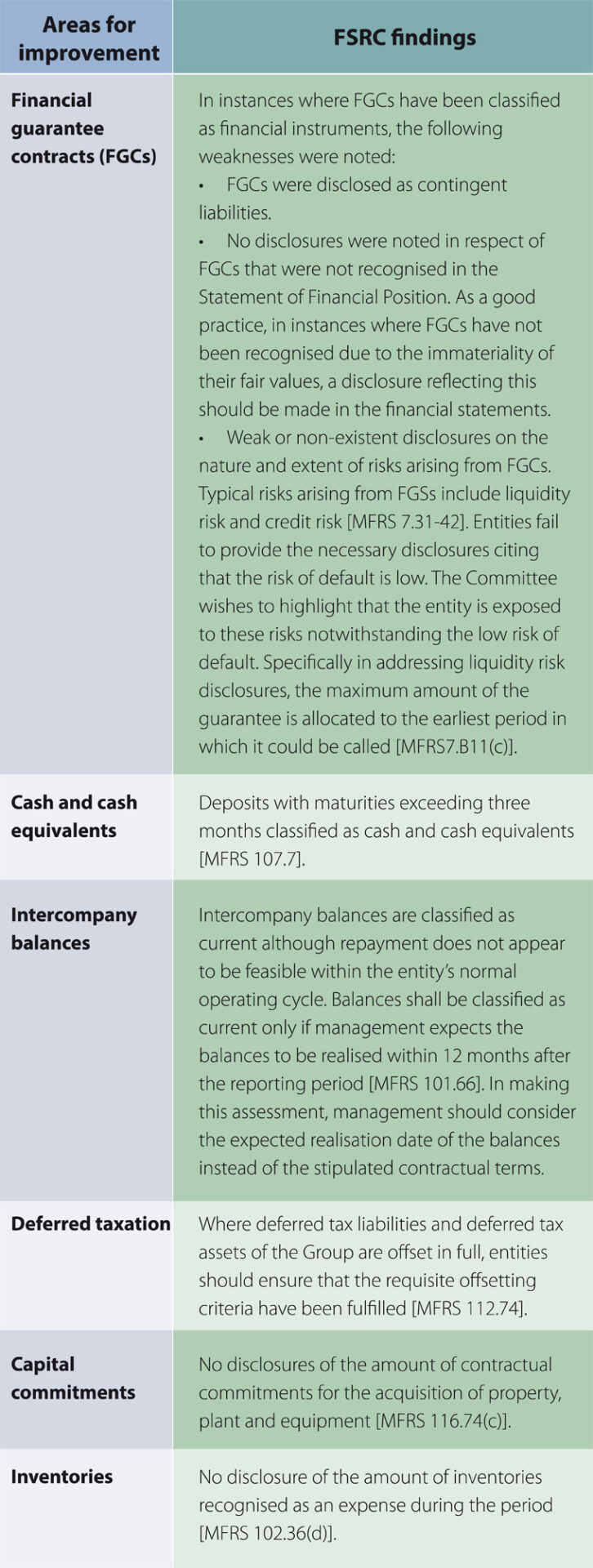The Financial Statements Review Committee highlights common deficiencies arising from the review of financial statements of public-listed entities for the period from July 2016 to June 2017.
by the MIA Financial Statements Review Committee
The financial statements serve as a fundamental communication tool in relaying the management’s objectives and processes while demonstrating governance over the assets they were entrusted with. In weaving the story of an entity, preparers of financial statements must decide on how much information they want to disclose to their users. A balance needs to be sought to ensure adequate information is disclosed in accordance with the applicable accounting standards.
In providing guidance to members on good financial reporting, the Financial Statements Review Committee (“FSRC” or “the Committee”) wishes to highlight common deficiencies arising from the review of financial statements of public-listed entities for the period from July 2016 to June 2017, highlighting areas that should be communicated better in the financial statements.
Does the entity have major customers?
Disclosures relating to major customers enable stakeholders to gauge an entity’s extent of reliance on its customers to generate sales. Major customers represent a significant concentration of risk to an entity. In volatile business environments, relationships between suppliers and customers are constantly shifting. Customers, in their search for better margins, may choose to switch suppliers or even move to develop products internally, adversely affecting the entity.
Approximately one-third of the financial statements reviewed were silent on whether the entity had any major customers. Disclosures on major customers are required by MFRS 8 “Operating Segments”. If revenues from transactions with a single external customer amounts to 10% or more of an entity’s revenue, the entity is required to disclose the following:
- The fact that there are customer(s) whose transactions amount to 10% or more of the entity’s revenue;
- The total amount of revenue from each customer identified in (i); and
- The identity of the segment(s) reporting the revenues.
However, the entity need not disclose the identity of the major customer(s) nor the amount that each segment reports from the said customer(s) [MFRS 8.34]. An example of how this disclosure requirement is met is illustrated via IG6 of MFRS 8 as follows:
“Revenues from one customer of the (XX) segment of the entity represents approximately (RM YY) of the entity’s total revenues.”
As a good practice, the Committee recommends that when the entity has a diversified customer base and there are no major customers as defined, the financial statements should include a disclosure reflecting these facts.
Are the entity’s related party transactions and balances clearly identified?
Entities are required to disclose, where material, the nature of the related party relationship as well as information about those transactions and outstanding balances, including commitments necessary for users to understand the potential effect of the relationship on the financial statements [MFRS 124.18]. In considering each possible related party relationship, attention is directed to the substance of the relationship and not merely the legal form [MFRS 124.10].
Commonly, an entity has a separate note in the financial statements dedicated to addressing related party disclosures. Alternatively, certain related party disclosures such as the remuneration received by key management, relationships between entities of the Group and intercompany balances are addressed in other notes to the financial statements. However, where these related party disclosures have been made in other notes to the financial statements, the Committee has noted that no references are made to identify these transactions and/or balances as related party disclosures.
In the sea of information provided in the financial statements, it is easy for a user to overlook the nature of these transactions unless clear distinction is made. These balances and/or transactions should be specifically identified as related party transactions and/or balances. Alternatively, references can be made from the related party disclosure note to the notes in which these balances and/or transactions are reflected highlighting them as related party disclosures.
While related party transactions are part and parcel of an entity’s business operating cycle, the influence of a related party might result in different transaction terms from those that would have been agreed between independent parties. In certain situations, the transactions would not have occurred if it were not made between the related parties. In making informed decisions, users should consider the impact of these transactions to the profits and financial position of the entity, should these transactions have occurred with independent parties to obtain a more holistic view of the entity’s performance.
Has the entity diversified its operations?
With dynamic business environments, it is common for entities to enter into new transactions, diversify into different industries and even enter into foreign markets. This diversification translates into new items to be reported in the financial statements.
The introduction of new items in the financial statements are often marred by poor disclosures. Namely, accounting policy choices relating to the new items are often non-existent; an indication that the significant accounting policies have merely been rolled forward from the previous financial year. There were no notes provided to describe the nature of the new items or the notes, if available, were insufficient.
As entities diversify their operations, they should apply the same robustness in articulating these changes in their financial statements. Similarly, where the results of an entity during the financial year were substantially affected by any item, transaction or event of a material and unusual nature, the Directors should specifically identify them in the Directors’ Report [5th Schedule, Companies Act 2016].
CONCLUSION
Above all, the FSRC wishes to reiterate that the responsibility for the preparation of financial statements under the Companies Act 2016 lies with the entity’s management and Board of Directors. Financial statements are accompanied by a statutory declaration made by the person primarily responsible for the financial management of the entity setting forth their opinion as to the correctness of the accompanying financial statements. [S251(b), Companies Act 2016]. Whilst auditors play an important role in enhancing the credibility of the financial statements, this role would be further enhanced with the entity’s management and Board of Directors engaging with the auditors throughout the financial reporting process.
The Financial Statements Review Committee (“FSRC” or “the Committee”) of the Institute was set up with the aim of upholding the quality of financial reporting of entities listed on Bursa Malaysia. The Committee reviews audited financial statements and audit reports that are prepared by or are the responsibility of members of MIA, for the purpose of determining compliance with statutory and other requirements, approved accounting standards and approved auditing standards in Malaysia.








